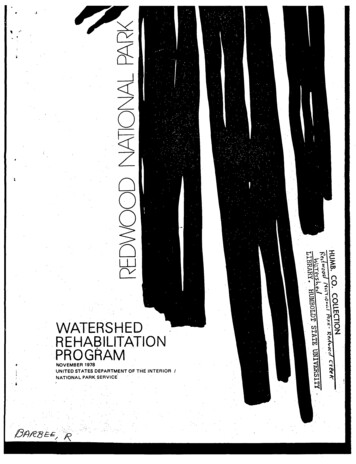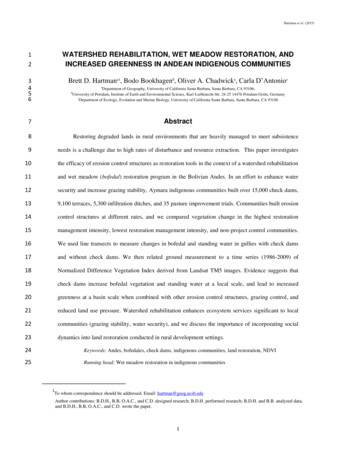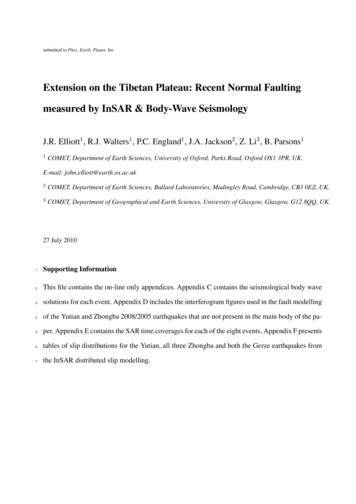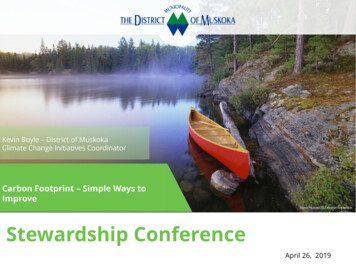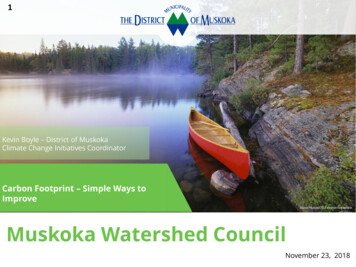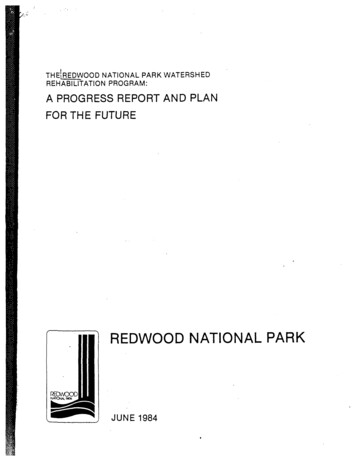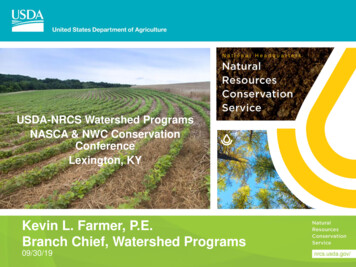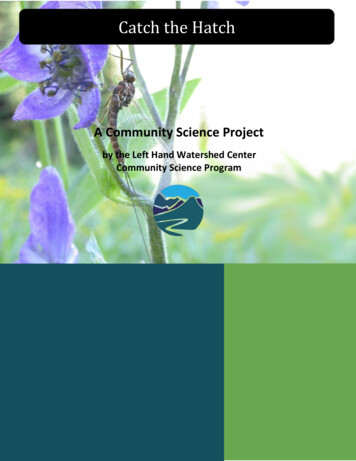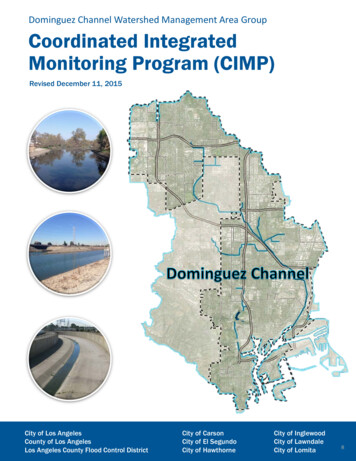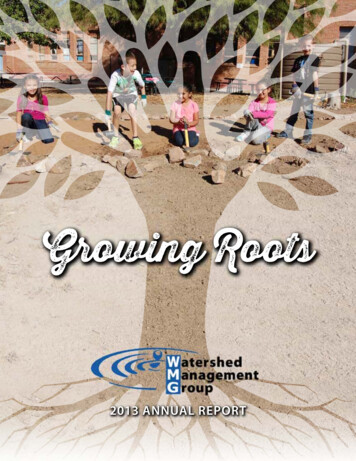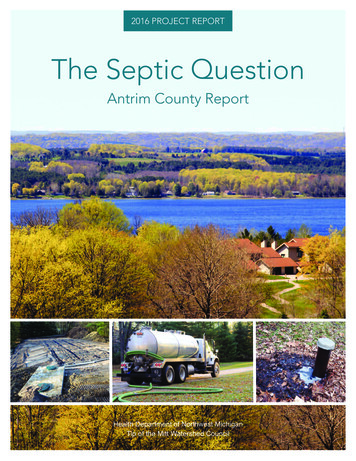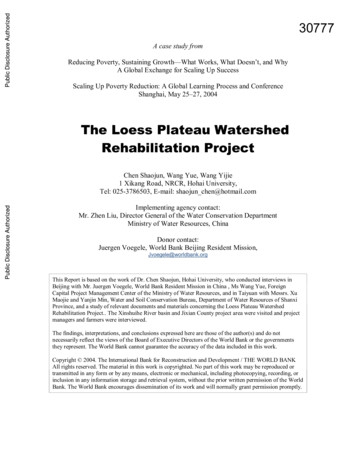
Transcription
Public Disclosure AuthorizedPublic Disclosure AuthorizedPublic Disclosure AuthorizedPublic Disclosure Authorized30777A case study fromReducing Poverty, Sustaining Growth—What Works, What Doesn’t, and WhyA Global Exchange for Scaling Up SuccessScaling Up Poverty Reduction: A Global Learning Process and ConferenceShanghai, May 25–27, 2004The Loess Plateau WatershedRehabilitation ProjectChen Shaojun, Wang Yue, Wang Yijie1 Xikang Road, NRCR, Hohai University,Tel: 025-3786503, E-mail: shaojun chen@hotmail.comImplementing agency contact:Mr. Zhen Liu, Director General of the Water Conservation DepartmentMinistry of Water Resources, ChinaDonor contact:Juergen Voegele, World Bank Beijing Resident Mission,Jvoegele@worldbank.orgThis Report is based on the work of Dr. Chen Shaojun, Hohai University, who conducted interviews inBeijing with Mr. Juergen Voegele, World Bank Resident Mission in China , Ms Wang Yue, ForeignCapital Project Management Center of the Ministry of Water Resources, and in Taiyuan with Messrs. XuMaojie and Yanjin Min, Water and Soil Conservation Bureau, Department of Water Resources of ShanxiProvince, and a study of relevant documents and materials concerning the Loess Plateau WatershedRehabilitation Project. The Xinshuihe River basin and Jixian County project area were visited and projectmanagers and farmers were interviewed.The findings, interpretations, and conclusions expressed here are those of the author(s) and do notnecessarily reflect the views of the Board of Executive Directors of the World Bank or the governmentsthey represent. The World Bank cannot guarantee the accuracy of the data included in this work.Copyright 2004. The International Bank for Reconstruction and Development / THE WORLD BANKAll rights reserved. The material in this work is copyrighted. No part of this work may be reproduced ortransmitted in any form or by any means, electronic or mechanical, including photocopying, recording, orinclusion in any information storage and retrieval system, without the prior written permission of the WorldBank. The World Bank encourages dissemination of its work and will normally grant permission promptly.
THE LOESS PLATEAU WATERSHED REHABILITATION PROJECTExecutive SummaryBreaking the vicious cycle of environmental deterioration and poverty and realizing naturefriendly development have been challenges for many countries in the world. The successfulimplementation of China’s Loess Plateau Watershed Rehabilitation Project, launched in 1994 andcompleted in 2002, provides valuable insights on how to meet those challenges. The LoessPlateau covers an area of some 640,000 square kilometers in the upper and middle parts of thedrainage basin of the Yellow River. Severe soil erosion from the Loess Plateau produces the vastquantity of sediment carried by the Yellow River and its tributaries. Unsustainable farmingpractices combined with huge population pressures have led to massive environmentaldegradation, downstream flooding, and widespread poverty in the Loess Plateau region.Implementation processThe primary objective of the project was to increase agricultural production and incomes on1,560,000 hectares of land in the Loess Plateau in nine tributary watersheds of the Yellow River.A secondary objective-- to reduce sediment inflows to the Yellow River--was achieved bylocating the project areas in those parts of the basin with severe soil erosion. Factors such aspoverty level, strong leadership, commitment at the local government level, and developmentpotential were also considered in the selection of project areas.Financed by the International Development Association (IDA), the Loess PlateauWatershed Rehabilitation area covers 1,560,000 hectares of the Loess Plateau in 21 counties, 17of which the government identified as among the poorest in China. Within the project areas thereare several distinct types of topography. In Gansu the gullied plateau landform is common, wherea flat plain with large tracts of level farmland is intersected by deep gullies. In Shanxi, Shaanxi,and parts of Inner Mongolia the gullied hill landform is common, where rounded hills severalhundred meters high are bounded by deep gullies. Field crops are grown on the plateaus and theupper slopes of the rounded hills. The steeper slopes are uncultivated wasteland. The deeplyincised gullies are a major source of the sediment that flows into the Yellow River and itstributaries.Typical land use in the small watersheds is uncultivated wasteland (40 percent); cropland(40 percent), mostly on low-productivity slopeland; trees and shrubs (10 percent); gullies (5percent); and roads, villages, and so on (5 percent). Annual precipitation, mostly as rain, rangesfrom 250 to 550 millimeters. Most of the rain falls in the summer, usually in short, intensestorms. Long droughts are common.The main components of the project were terraces (90,500 ha); forestation (90,900 ha);shrubs (136,000 ha); economic forestation (26,700 ha); orchards (30,890 ha); grasslands (100,140ha); irrigation (7,100 ha); sediment control dams (149 key dams, 1,140 warping dams, and 1,956check dams); and institutional support (training centers, vehicles and equipment, computers, andsoftware for GIS and information systems). An IDA credit of 150 million covered 60 percent ofthe total project cost of 250 million; the cost per hectare was about 160.1
CASE STUDIES IN SCALING UP POVERTY REDUCTIONImpact analysisThe project aimed to (a) create sustainable crop production on high-yielding level farmland andthereby replace the areas devoted to crops on erosion-prone slope lands; (b) plant the slopelandsto a range of trees, shrubs, and grasses for land stabilization and the production of fuel, timber,and fodder; and (c) substantially reduce sediment runoff from slopelands and gullies. Theseobjectives were met and enhanced by a decision by the local authorities to restrict free grazing ofsheep and goats, not only in the project areas, but also in large areas outside the project. Farmershave adjusted to grazing bans more readily than expected. Government leaders at all levels haveno doubt that the wide acceptance of grazing bans is a direct result of the project, and manybelieve they are witnessing a revolution in land and livestock management in the Loess Plateau.The objectives of the project—sustainable and coordinated social, economic, resourceand environmental development of small watersheds—are consistent with the poverty reductionstrategy of the Chinese government’s Eight-Seven Poverty Reduction Program (to eliminatepoverty for 80 million people within seven years, from 1994–2000). The shift from relief todevelopment in the government’s poverty reduction strategy enhances the capacity of the povertypopulation to share in the opportunities brought about by economic reforms. By combining theharnessing of small watersheds with economic development and the improvement of people’sliving standards, the Loess Plateau project fully reflects the rationale of “sustainable smallwatershed development.”The project has turned out to be the largest and most successful water and soilconservancy project in the world. It has convinced planners and farmers that land conservation iscompatible with sustainable and productive agriculture and, indeed, that they are mutuallyreinforcing, an approach now being adopted in other parts of the Loess Plateau. It has broughtsignificant benefits to over 1.2 million farmers in the project area. Thanks to the implementationof the Loess Plateau Watershed Rehabilitation Project and the government’s poverty alleviationpolicies, the population living under the poverty line in the project area has dropped from 59percent in 1993 to 27 percent in 2001.Driving factors and lessons learnedAmong the factors driving the project have been a political commitment for change; publicparticipation, including detailed land-use plans prepared in close consultation with villages; andthe government’s policy for land tenure. The project worked with China’s public administrationand developed existing institutions in it. It was inevitable that problems would be encounteredand new approaches developed. The World Bank played an important role in project preparationand implementation. Among the specific lessons learned: Soil and water conservation in the Loess Plateau is compatible with sustainable andproductive agriculture. The project has convinced planners and farmers that land conservationis compatible with sustainable and productive agriculture. Integrated and comprehensive land-use plans must be prepared for all small watersheds inclose cooperation with the farm households and village leaders. These should delineate the2
THE LOESS PLATEAU WATERSHED REHABILITATION PROJECTpresent situation and the future development plan. Such plans would create sustainable cropproduction on high-quality terraces, and protect steep slopes with trees and shrubs. Farmers should receive long-term land contracts. All land developed under a rehabilitationproject should be contracted out to farmer households. New land contracts should explicitlystate the land-use rights and obligations under which farmers' interests will be legallyprotected. Typically, contracts should be for a minimum of 50 years for slope and waste land,50 years for forestry plots, and 30 years for orchards, terraces, and warping land. After treeplanting, the wasteland should be auctioned to farmers and successful bidders given a longterm contract. Costs should be recovered from the beneficiaries. In the IDA project, about 60 percent of theproject cost was recovered from the beneficiaries, providing incentives to maintain anddevelop the land and reduce the burden on public funds. Counties should make a detailed physical check of progress and quality; prefectures andprovinces should make periodic spot checks. Funds should be disbursed only for workinspected and approved. Project management offices should be set up at all levels and staffed with experiencedpersonnel.Components for future projectsIn many villages in the Loess Plateau, villagers have to haul water for domestic use from longdistances. Underground water tanks should be a part of future projects. They can be located tocollect runoff from the roads and from flat surfaces in the villages and homesteads. More supportshould be given to farmers to switch from free grazing to pen feeding, especially by introducingimproved breeds of sheep and goats and seeds for improved pasture.3
THE LOESS PLATEAU WATERSHED REHABILITATION PROJECT2. Implementation Progress2.1 Project BackgroundChina is making the transition from an agricultural society to an industrialized and modernizedone, and from a planned economy to a socialist market economy. However, China remains acountry with a large agricultural population. Agriculture provides the basic daily necessities for1.3 billion people and agriculture is the main source of income for 200 million farm families.Soil erosion causes the loss of about 5 billion tons of surface soil annually. The amountof organic fertilizer lost due to soil erosion in the past decade was equivalent to the total fertilizerproduction in the same period of time. Located in the west of China and in the middle reaches ofthe Yellow River, the Loess Plateau covers an area of some 640,000 sq km in the upper andmiddle parts of the drainage basin of the Yellow River. Severe soil erosion from the LoessPlateau produces the vast quantity of sediment carried by the Yellow River. The Plateau washeavily forested about 2,000 years ago, but forest cover now ranges form 5 to 15 percent. Thecauses of deforestation are complex. The Plateau was the scene of vast population movementsand conflicts as well as climatic cycles marked by decades of severe droughts. Unsustainableagricultural practices have also accelerated erosion and deforestation and the people living in themore remote parts of the plateau are caught in a poverty trap. Silt transported to the lowerreaches of the Yellow River over the years continues to raise the river bed. As a result, the flooddikes have to raised and river training works strengthened.Within the project areas there are several distinct types of topography. In Gansu the"gullied plateau" landform is common, where a flat plain with large tracts of level farmland isintersected by deep gullies. In Shanxi, Shaanxi, and parts of Inner Mongolia the "gullied hill"landform is common where rounded hills several hundred meters high are bounded by deepgullies. Field crops are grown on the plateaus and the upper slopes of the rounded hills. Thesteeper slopes are uncultivated wastelandSince the 1978 reforms in China, the poverty population in China has fallendramatically. According to the standard of poverty of the Chinese Government, the povertypopulation has dropped from 250 million to 42 million in 1998 and further to 28.2 million in2002. There were 592 poverty counties listed in the National Eight-Seven Poverty ReductionProgram in 1994. The Loess Plateau Watershed Rehabilitation Project involved 21 counties infour provinces and autonomous region of Shaanxi, Shanxi, Gansu and Inner Mongolia accountingfor 25.7 percent of the total number of counties. Among the total poverty population of 80.6million, there were 14.5 million in the four project provinces and autonomous region. However,the more they farmed the infertile soil, the poorer the farmers became: and the poorer the farmersbecame, the more they farmed the soil, forming a vicious cycle from which the farmers could notescape.Over the 40 years since the founding of new China to the early 1990’s, the Chinesegovernment has implemented many programs to control soil erosion in the Loess Plateau areas5
CASE STUDIES IN SCALING UP POVERTY REDUCTIONand made significant progress. However, the quantity and magnitude of soil erosion in this area isenormous, the ecological environment is fragile, agricultural production is extensive andbackward and the economic base is poor. Therefore, the annual rate of harnessing in the past 40years was only about 0.8 percent. In order to effectively control and harness soil erosion in anoverall manner in the Loess Plateau, the investment must be increased and the quality ofharnessing should be improved.2.2 Rationale and ObjectivesSince the problem of soil erosion in the Loess Plateau is severe and the people there live inpoverty, the Chinese government used a Credit from the World Bank Group for the Loess PlateauWatershed Rehabilitation Project, a large-scale project for water and soil conservation, The LoessPlateau is located in the western region of China and the upper and middle reaches of the YellowRiver It covers parts of the seven provinces and autonomous regions of Qinghai, Gansu, Ningxia,Inner Mongolia, Shaanxi, Shanxi and Henan, and covering an area of 640,000 km2. The Projectarea is located in nine river basins in Shanxi, Shaanxi, Inner Mongolia and Gansu. The totalproject area while the total area is 15,500 km2, of which soil erosion area is 14,000 km2accounting for 90 percent of the total area. The Project involves 2,137 administrative villages in22 counties in seven prefectures with a total population of 1.24 million, of which the agriculturalpopulation was 1.21 million. The total investment of the Project was Yuan 2.1 billion, of whichthe IDA Credit was US 150 million dollars The Project was launched in October 1994 andcompleted in 2002.The primary objective of the project was to increase agricultural production and incomeson 1,560,000 ha of land in the Loess Plateau in nine tributary watersheds of the Yellow River. Asecondary objective-to reduce sediment inflows to the Yellow River-was achieved by locating theproject areas in the parts of the Basin with severe soil erosion. Factors such as poverty level,strong leadership and commitment at the local government level and development potential werealso considered in the selection of project areas.The objectives of the Project are consistent with the poverty reduction strategy of theChinese government’s “Eight-Seven Poverty Reduction Program” (solve poverty for 80 millionpeople within 7 years from 1994-2000). The shift from “relief” to “development” in theGovernment’s poverty reduction strategy enhances the capacity of the poverty population to sharein the opportunities brought about by economic reforms. Meanwhile, the Government’sobjectives are in line with that of poverty reduction strategy agreed by leaders of states during theMillennium Summit of September 2000. The Project does not aim solely at soil erosion control,and not solely at poverty reduction either. It is aimed at sustainable and coordinated social,economic, resource and environmental development of small watersheds; it integrates harnessingof small watersheds with economic development and the improvement of people’s livingstandards, and it fully reflects the rationale of “sustainable small watershed development”.6
THE LOESS PLATEAU WATERSHED REHABILITATION PROJECT2.3 Project componentsThe Loess Plateau Watershed Rehabilitation Project has two parts: one is to conserve land,control sediment, and enhance farm incomes through terracing, afforestation, and orchards, grassgrowing, construction of sediment control dams; the second is capacity building such as training,scientific research and technique promotion. The main components of the Project are: terraces(90,500 ha), afforestation (90,900 ha), shrubs (136,000 ha), economic forest (26,700 ha), orchards(30,890 ha), grasslands (100,140 ha), irrigation (7,100 ha) sediment control dams (149 key dams,1,140 warping dams, and 1,956 check dams), and institutional support (training centers, vehiclesand equipment, computers and software for GIS and information systemsThe Project began in1993 and was completed in 2002. An IDA Credit of US 150 million covered 60 percent of thetotal project cost of U 250 million; a cost per ha of about 160. The proceeds of the Credit wereon-lent to the provinces.3. IMPACT ANALYSIS3.1 Component Effectiveness Review3.1.1 TerracingTerracing of slopeland can increase farm income effectively control soil erosion and realizesustainable land. It makes it possible to take steep slopelands out of agriculture. In XinshuiheRiver basin, 12,630 ha of terracing were completed. At the same time the terraces are constructed,farm roads and village roads were built. In the project area, roads connect all villages and farmfields. Thanks to the road network, farmers can now use small power implements and vehicles fortransportation, cultivation, and harvest.The cultivated land area in Xinshuihe River basin was reduced from 45,496 ha in 1994 to39,938 ha in 2001 due to terracing of slopeland. The proportion of terrace increased from 24percent in 1993 to 60 percent in 2001. We visited some farmers in project area, who told us:“Before the project, the wheat output per ha was about 100 kg per mu (one fifteenth of a ha) and150 kg at the most, just enough to feed the family. But now, the ordinary output is above 2000 kg.This year, because of good rainfall, the output of many households is between 250 kg to 300 kg.You could not imagine this in the past. Therefore, our income increased Yuan 100 per mu. In thepast, the corn output was 150 to 200 kg, but now the output increases to 400 to 450 kg. And thisyear, it’ll be above 500 kg. Terracing makes it possible to grow crops with plastic film, which isimpossible with slopelands.”Most importantly, terraces not only increased grain output but also reduced farmers’labor input. The wider and better farm roads mechanized farming possible so that farmers couldfind some new living methods like livestock production and off farm employment.But in the non-project area, Mr. Liu (at the age of 30) of Lanjiahe Village,Shangyangzhuang, Ji County said:” many farmers in the village want to convert slopelands into7
CASE STUDIES IN SCALING UP POVERTY REDUCTIONterrace b
Watershed Rehabilitation area covers 1,560,000 hectares of the Loess Plateau in 21 counties, 17 of which the government identified as among the poorest in China. Within the project areas there are several distinct types of topography. In Gansu the . gullied plateau. landform is common, where
